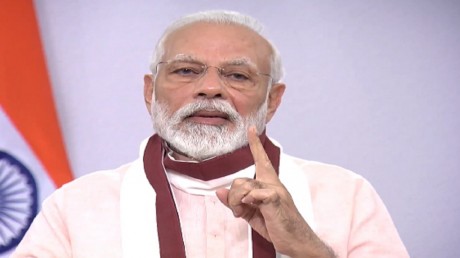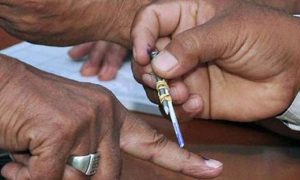Sometime around 1990, when the then Bharatiya Janata Party (BJP) president Lal Krishna Advani made a big push for the party’s run to power, in his Rath Yatra to build a Ram Temple in Ayodhya, RSS ideologue KN Govindacharya used to say: “We are not the alternative to Congress. We are the next Congress.”
Both Advani and Govindacharya have substantially been relegated to the background in the BJP these days, but what the latter said then rang significantly true on Wednesday, as Prime Minister Narendra Modi gave his fifth Independence Day address. The speech from the ramparts of the Red Fort was strong on inclusiveness, modernity and a pan-India outlook, a far cry from the origins of the RSS.
The RSS, obsessed with history and ancestry, used to speak of ‘Hindi, Hindu, Hindustan’. Modi’s shift from that to ‘Reform, Perform, Transform’ symbolises both the acknowledgment that it takes a lot more to sustain power over a vast India, and an ambition to match the compulsion. His formula for that included factoids that smelt of technology, a futuristic outlook, women’s empowerment and opportunities for youth.
The big question is whether ground realities and local perceptions in the sprawling Indian landscape are good enough for people to buy into the cocktail of slogans, statistics and statements that Modi spewed in his 80-minute-long speech.
Have no doubt, this was an election year speech — but credit goes to Modi for toning down the aggression and rhetoric that marked his rise to power in 2014, and for swapping these for statesmanly idioms. But idioms win over critics, not voters. His platter, therefore, offered several promises in a hold-all phrase that the prime minister wants: “Home, health, toilet, power and skill for all.” And, of course, digital connectivity.
Modi’s big promise, as expected, was in giving a measure of forward push to last Budget’s vague announcement of the ‘Ayushman Bharat’ scheme, now repackaged as the Pradhan Mantri Jan Arogya Abhiyaan, as he aimed to bring health insurance benefits of Rs 5,00,000 each to 10 crore families — or 50 crore people, marking nearly half the population.
A lot now depends on the timeline and the rollout, or whether the people of India feel sufficiently enthused by the past four years to give the prime minister the benefit of doubt on whether he can execute what he aims for with a late promise.
For his part, Modi pointed out to how his government had weeded out 6 crore dubious welfare beneficiaries and cracked down on black money to improve administration.
The best thing going for Modi is something he mentioned in his speech: That 65 percent of India’s population is below the age of 35. Thanks to this, the NDA government has a virtual blank slate in which it can sidestep its historical quirks while claiming credit for continuity as change.
For instance, the prime minister claimed 2 crore people had moved above the poverty line in the last two years, while the truth is that this is part of a long-drawn out process that dates back to Indira Gandhi’s ‘Garibi Hatao’ days in the 1970s, and successive poverty alleviation programmes from the Janata Party’s (1977-1980) early food-for-work ideas to the UPA’s National Rural Employment Guarantee Scheme three decades later under a special job support law. The same goes for rural electrification as well.
Modi spoke extensively on the North East, women and farmers. He quoted Tamil poet Subramania Bharati known for his nationalist passion and Dalit leader Babasaheb Ambedkar. Finance Minister Arun Jaitley’s Twitter greeting on Independence Day featured a visual that marked freedom struggle leaders including Bhagat Singh and Sardar Patel — while carefully excluding the Nehru-Gandhi family.
All of this clearly shows a political appropriation and inclusion plank that the BJP is pursuing — to be a pan-Indian force transcending old ideological or party differences.
Understandably, therefore, the BJP has downplayed or outright sidelined its traditional heroes — Savarkar, Golwalkar or even the founder of the Jana Sangh (BJP’s previous avatar) Syama Prasad Mukherjee. The singular ideological inspiration now is Deen Dayal Upadhyay, known for “integral humanism” that stayed somewhat clear of ‘Hindutva’ and after whom Modi’s grandiose health insurance scheme has now been named.
Upadhyay’s name is already attached to the former Mughal Sarai railway station, and is also aimed for Agra’s airport. The new ambitious health insurance scheme will be launched on Upadhyay’s birth anniversary on 25 September, closer to Assembly elections in Rajasthan, Madhya Pradesh and Chattisgarh — not to speak of general elections.
A lot depends, however, on the economy and jobs in the hinterland. If the UPA government was accused of “policy paralysis”, NDA is being criticised for what it means for the poor. From demonetisation of high-value currency notes and GST’s implementation to the revival of bad loan-hit banks, the Opposition’s narrative is all about what this means for jobs and livelihood.
Modi’s speech mentioned 13 crore as the number of beneficiaries under the self-employment-oriented MUDRA loan scheme. Can this and the ‘Modicare’ health insurance scheme generate enough positive buzz across small town India to win over hundreds of millions of hearts? We will have to wait and see.
In a speech that spoke of India’s power to launch satellites, Modi promised to have a manned mission in space by 2022 — although technically, an Indian, Rakesh Sharma was part of a Soviet space mission in 1984, becoming the first Indian in space.
Modi’s carefully constructed speech straddled high ambitions on the one hand and the needs of the lower strata on the other. “The sleeping elephant has woken up,” he said of India.
In a nation of 125 crore people, the question is whether the awake elephant is sprightly enough to dance or run. Modi’s critics are betting that his speed may lag his aim, while his supporters would hope that his direction will compensate for what he lacks in speed and detail.
For more updates: Like us on Facebook and follow us on Twitter & Instagram





































